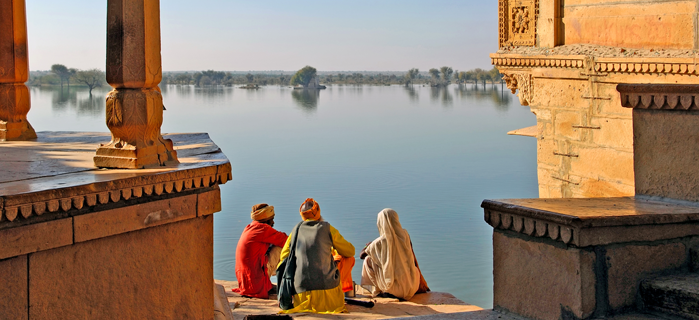India. Just the name evokes images of the colorful and sprawling alleys of Mumbai, the chaos of vast city bazaars in Old Delhi, or the grandeur of striking temples like the Taj Mahal, known the world over.
Aside from its rich culture and fast pace of commerce and development, India is also the world's most populous democracy with a population of over 1.2 billion people that is set to surpass China's within the next decade. From tech startups and tourism to natural resources and agriculture, India's position in the world is marked by tremendous economic opportunity. Already, India is one of the largest trading partners of the US with economic growth that outpaces China.
The relationship between the US and India, in particular, is crucial for strengthening democracy across the world, supporting a strong global economy, achieving Global Goals outlined by the United Nations, and developing cultural ties between its citizens. Speaking each other's language is, of course, indispensable to collaboration and friendship between the two countries. Although India has over 122 major spoken languages with English used in some parts of the country Hindi serves as the unifying language not only for the people of India but also for the wider South Asia region. Speaking Hindi can open up opportunities to communicate with Urdu speakers in Bangladesh and Pakistan, since the two languages are closely related in terms of vocabulary.

Despite its standing as a critical language for Americans to learn, Hindi is not a commonly taught language in the US, with few Americans receiving the opportunity to learn about Indian language, culture, and customs. Whether young Americans aspire to launch a tech startup, produce films, facilitate international trade, impact environmental and energy relations, or monitor international military issues, learning Hindi and understanding the significance of India will set them apart in the global job market and welcome them into a diverse culture steeped in ancient history.
International exchange programs and organizations are working to bridge the gap and prepare future US leaders to engage with India on both a personal and professional level. As we celebrate #WorldHindiDay, meet two young Americans who took on the challenge of studying Hindi and immersing themselves in Indian culture.

Rhea: Developing Lifelong Ties with the Hindi Community
I initially became interested in Hindi through Bollywood music and films, but my interest in India quickly influenced my undergraduate and then my graduate research in conflict resolution. This culminated in my graduate dissertation, which focused on the discourse of Kashmir's self-determination movement.
The summer after my graduation, I embarked on the Critical Language Scholarship Program (CLS) to Jaipur, India, where I dove headfirst into Hindi and North Indian culture. Even when I was briefly quarantined at the house of my host family with Chickenpox, I eagerly explored Hindi medical terms and Ayurveda healthcare remedies. I was struck by the fact that, despite the prevalence of English in India, Indians were always exuberant to discover that I was learning one of their languages. Everyone from my host family's neighbors to airport security guards was so excited to hear me speak Hindi always insisting that it was very good!
After returning to the US, I took Hindi classes at the University of Virginia, which helped me connect to a large community of South Asians and their culture and heritage in central Virginia. Exploring these traditions and cultures in my home turf has also been quite rewarding and has led to many lasting connections.
Although the US and India are very large countries, I have found that the Hindi-Urdu learning community in the US is a small world everyone seems to know everyone. It is a warm and vibrant community of learners, and I am happy to work in my position of adding new learners to the community every summer through the CLS Program.
Throughout the years I have found that my one summer in India continues to inform new experiences. Last year, while visiting New York City for the first time, my first impression was that it was a reflection of New Delhi. And most recently, while traveling in Indonesia, I was struck by the many Sanskrit and Hindi words in Bahasa Indonesian remnants of Hinduism, Buddhism, and contact with India that took place starting in the 1st-century. Visiting ancient Hindu temples around Malang, Indonesia was intriguing as I recognized the great reach and history of Indic languages.

Claudia: Learning Hindi as a Tool for International Development
As an undergraduate student majoring in international development, I became increasingly interested in the economic and social juxtapositions that existed within India. I wanted to take my education a step further and decided to study abroad in Pune, India during the fall semester of my junior year through the Alliance for Global Education.
I enrolled in a Beginner's Hindi course to better communicate with my host family and community. I looked forward to our lessons every day, where I learned new phrases and vocabulary and practiced them with shopkeepers and members of my host family. Learning the alphabet was particularly special because each character looked like its own work of art. Despite the challenges of learning a new language, it was encouraging to see how far my classmates and I had advanced by the end of the semester.
Once I became (somewhat) conversational, I was able to speak to people from different age groups, social classes, and backgrounds. This was especially useful when I interned with a microfinance organization in Pune that used group-lending practices in several slum communities to help increase household incomes and financial literacy to families in those areas. Studying economic development in this way and listening to first-hand experiences of how micro-lending was a successful tool for people in these communities really impacted my outlook on the field and the rest of my college career.
On a more personal note, learning Hindi also opened up many new experiences, friendships, and connections with the local culture that I wouldn't have otherwise been able to access without the language. When I came back to the US, I was eager to engage with the South Asian community in Washington, D.C., and took Bhangra lessons, joined a Hindi language group, and attended political discussion events at think tanks.
Learning Hindi has allowed me to not only have the opportunity to communicate with an enormous group of people around the world, but also to gain a different perspective and lens on the issues impacting other countries. I hope to continue studying Hindi whenever possible and to return to India in the near future and reconnect with my host family.
Are you a Hindi speaker? What were your experiences learning Hindi and exploring Indian culture? We'd love to hear from you: Share your story with us on Twitter and use the #LanguageMatters hashtag.
Opportunities to Learn Hindi
Boren Awards South Asian Flagship Language Initiative
Critical Language Scholarship Program
National Security Language Initiative for Youth
US Department of State Passport to India Initiative

